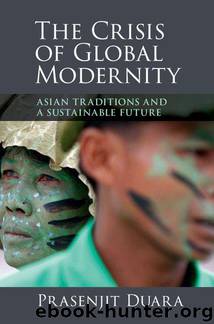The Crisis of Global Modernity: Asian Traditions and a Sustainable Future (Asian Connections) by Prasenjit Duara

Author:Prasenjit Duara [Duara, Prasenjit]
Language: eng
Format: epub
Publisher: Cambridge University Press
Published: 2014-12-31T08:00:00+00:00
Dialogical transcendence and popular religion
Although the emperor claimed exclusive access to Heaven, the Chinese imperial model was not a theocracy. Local communities were permitted to worship a panoply of gods and religions, and the court itself was filled with a variety of jockeying religious representatives. But the imperial state remained suspicious of popular cults and spirit mediums for harboring heterodox views, not only because they might seek to usurp the mandate of Heaven, but also because they engaged in ideologically ‘destabilizing’ activities, such as the unauthorized mixing of men and women. Periodically, both state and elites conducted campaigns to sweep out popular religions that were not state-oriented or part of the state cult, such as those led by Chen Hongmou in the eighteenth century. Thus, many of the ideas and practices related to alternative conceptions and popular access to Heaven were driven deeper into popular culture, where they mingled and often camouflaged themselves in the thicket of popular religiosity. Here it would be difficult to do what a minister of the state of Chu had counseled: “to cut the communications between Heaven and Earth” so as to prevent “each household indiscriminately performing for itself the religious observances.”
Early observers of community religion in village society were deeply impressed by the pervasive presence of the state cult, particularly as expressed in the tutelary gods and the celestial bureaucracy modeled on the imperial bureaucracy.35 More recently, Stephan Feuchtwang and others have argued that the differences between the state cult and popular religion were both organizationally and cosmologically significant. Popular religion conceived the cosmos as more personalized and violent, with threatening and rewarding forces operating through mythic efficacy.36 Licensed institutionalized versions of Buddhism and Daoism seem to have had a relatively marginal role in the lives of ordinary people by the late Qing period.
But what I have earlier identified as the cultural nexus of power in rural society – networks of communities, beliefs and practices through which local leaders exercised their normative leadership and mediated the relationships of the community with the outside within a cultural framework – also served as a series of overlapping, camouflaging and translucent canopies from the viewpoint of higher authorities and orthodoxy. These canopies mediated between the higher and lower levels and often camouflaged alternative claims to and of transcendence, temporalities, and social statuses. Thus, Buddhist monks were mainly called on only to perform funerary rites and Daoists as experts in exorcism and prophesy, but communal religion frequently absorbed non-orthodox rites and ideas from these religions. This absorption was relatively unsupervised because many of these monks and priests were themselves not ordained or socialized by institutionalized Buddhism and Daoism.
Under the canopies, popular religiosity turned out to be a vibrant field of communication and negotiation, accommodation and adaptation, and camouflage and resistance between state orthodoxy and popular cultural nexus, enabled in part because different groups of elites participated in several different spheres between the top and the bottom. In an earlier study of the Guandi cult, I tried to show
Download
This site does not store any files on its server. We only index and link to content provided by other sites. Please contact the content providers to delete copyright contents if any and email us, we'll remove relevant links or contents immediately.
Cecilia; Or, Memoirs of an Heiress — Volume 1 by Fanny Burney(32495)
Cecilia; Or, Memoirs of an Heiress — Volume 2 by Fanny Burney(31909)
Cecilia; Or, Memoirs of an Heiress — Volume 3 by Fanny Burney(31893)
The Great Music City by Andrea Baker(31758)
We're Going to Need More Wine by Gabrielle Union(19003)
All the Missing Girls by Megan Miranda(15779)
Pimp by Iceberg Slim(14434)
Bombshells: Glamour Girls of a Lifetime by Sullivan Steve(14022)
For the Love of Europe by Rick Steves(13589)
Talking to Strangers by Malcolm Gladwell(13290)
Norse Mythology by Gaiman Neil(13279)
Fifty Shades Freed by E L James(13187)
Mindhunter: Inside the FBI's Elite Serial Crime Unit by John E. Douglas & Mark Olshaker(9263)
Crazy Rich Asians by Kevin Kwan(9223)
The Lost Art of Listening by Michael P. Nichols(7453)
Enlightenment Now: The Case for Reason, Science, Humanism, and Progress by Steven Pinker(7273)
The Four Agreements by Don Miguel Ruiz(6701)
Bad Blood by John Carreyrou(6583)
Weapons of Math Destruction by Cathy O'Neil(6215)
